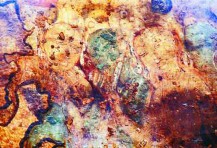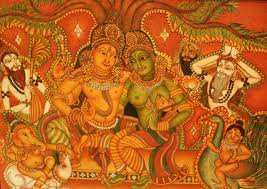Later Murals
Even after Ajanta, very few sites with paintings have survived which provide valuable evidences to reconstruct the tradition of paintings. It may also be noted that the sculptures too were plastered and painted. The tradition of cave excavations continued further at many places where sculpting and painting were done simultaneously.
10.1 Badami paintings

Badami is a cave site in the state of Karnataka. It was the capital of western chalukyan dynasty. The chalukya king, Manglesha, patronized the excavations of the Badami caves.
The patron record of cave shows Vaishnava affiliation. Therefore the cave popularly known as Vishnu cave. Only a fragment of painting has survived on the vaulted roof of the front mandapa.
Paintings in these caves depict palace scenes. One shows the Kirtivarman, the son of pulakesin-
I. Stylistically speaking, the painting represents an extension of the tradition of mural painting from Ajanta to Badami in south India. The sinuously drawn lines, fluid forms and compact composition exemplify the proficiency and maturity of the artist. The gracefully drawn faces of the king and queen remind us of the style of modeling in Ajanta.

It is noteworthy to observe that the contours of different parts of the face of the face create protruding structures of face itself. Thus, with simple line treatment artist could create volume.
